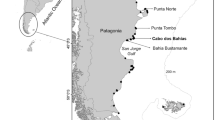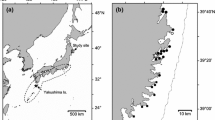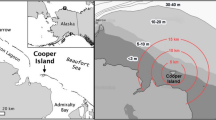Abstract
The white-chinned petrel (Procellaria aequinoctialis) is the seabird species most commonly killed by Southern Hemisphere longline fisheries. Despite the importance of diving ability for mitigating longline bycatch, little is known of this species’ diving behaviour. We obtained data from temperature–depth recorders from nine white-chinned petrels breeding on Marion Island, southwestern Indian Ocean, during the late incubation and chick-rearing period. Maximum dive depth (16 m) was slightly deeper than the previous estimate (13 m), but varied considerably among individuals (range 2–16 m). Males dived deeper than females, and birds feeding chicks dived deeper than incubating birds, but dive rate did not differ between the sexes. Time of day had no significant effect on dive depth or rate. Our findings will help to improve the design and performance of mitigation measures aimed at reducing seabird bycatch in longline fisheries, such as the calculation of minimum line sink rates and optimum aerial coverage of bird-scaring lines.



Similar content being viewed by others
References
Aguilar JS, Benvenuti S, Dall-Antonia L, McMinn-Grive M, Mayol-Serra J (2003) Preliminary results on the foraging ecology of Balearic shearwaters (Puffinus mauretanicus) from bird-borne data loggers. Sci Mar 67:129–134
Barnes KN, Ryan PG, Boix-Hinzen C (1997) The impact of the hake Merluccius spp. longline fishery off South Africa on procellariform seabirds. Biol Conserv 82:227–234
BirdLife International (2014) Species factsheet: Procellaria aequinoctialis. http://www.birdlife.org on April 8, 2014
Brown RGB, Bourne WRP, Wahl TR (1978) Diving by shearwaters. Condor 80:123–125
Burger AE (2001) Diving depths of shearwaters. Auk 118:755–759
Burger AE, Wilson RP (1988) Capillary-tube depth gauges for diving animals: an assessment of their accuracy and applicability. J Field Ornithol 59:345–354
Cherel Y, Weimerskirch H, Duhamel G (1996) Interactions between longline vessels and seabirds in the Kerguelen waters and a method to reduce seabird mortality. Biol Conserv 75:63–70
Cook TM, Cherel Y, Bost C-A, Tremblay Y (2007) Chick-rearing Crozet shags (Phalacrocorax melanogeni) display sex-specific foraging behaviour. Antarct Sci 19:55–63
Delord K, Gasco N, Weimerskirch H, Barbraud C (2005) Seabird mortality in the Patagonian toothfish longline fishery around Crozet and Kerguelen Islands, 2001–2003. CCAMLR Sci 12:53–80
Freeman A, Nicholls D, Wilson K, Bartle J (1997) Radio and satellite tracking Westland Petrels Procellaria westlandica. Mar Ornithol 25:31–36
Harper PC (1987) Feeding behaviour and other notes on 20 species of Procellariiformes at sea. Notornis 34:169–192
Huin N (1994) Diving depths of white-chinned petrels. Condor 96:1111–1113
Jimenez J, Domingo A, Abreu M, Brazeiro A (2012) Bycatch susceptibility in pelagic longline fisheries: are albatrosses affected by the diving behaviour of medium-sized petrels? Aquatic Conserv Mar Freshw Ecosyst 22:436–445
Kato A, Ropert-Coudert Y, Grémillet D, Cannell B (2006) Locomotion and foraging strategy in foot-propelled and wing-propelled shallow-diving seabirds. Mar Ecol Prog Ser 308:293–301
Keitt BS, Croll DA, Tershy BR (2001) Dive depth and diet of the black-vented shearwater (Puffinus opisthomelas). Auk 117:507–510
Kuroda N (1954) On the classification and phylogeny of the order Tubinares, particularly the shearwaters (Puffinus), with special consideration on their osteology and habitat differentiation. Kuroda, Tokyo
Lewis S, Benvenuti S, Dall-Antonia L, Griffiths R, Money L, Sherratt TN, Wanless S, Hamer KC (2002) Sex-specific foraging behaviour in a monomorphic seabird. Proc R Soc Lond B 269:1687–1693
Mackley EK, Phillips RA, Silk JRD, Wakefield ED, Afanasved V, Furness RW (2011) At-sea activity patterns of breeding and nonbreeding white-chinned petrels Procellaria aequinoctialis from South Georgia. Mar Biol 158:429–438
Marchant S, Higgins PJ (1990) Handbook of Australian, New Zealand and Antarctic birds vol 1 ratites to ducks. Oxford University Press, Melbourne
Melvin E, Guy T, Rose B (2009) Branchline weighting on two Japanese joint venture vessels participating in the 2009 South African tuna fishery: a preliminary report. Washington Sea Grant, University of Washington, Seattle
Melvin E, Guy T, Sato N (2011) Preliminary report of 2010 weighted branchline trials in the tuna joint venture fishery in the South African EEZ. Agreement on the Conservation of Albatrosses and Petrels. Fourth Meeting of the Seabird Bycatch Working Group. Guayaquil, Ecuador. http://www.spc.int/DigitalLibrary/Doc/FAME/Meetings/WCPFC/SC7/EB-WP-08.pdf
Melvin EF, Guy TJ, Read LB (2014) Best practice seabird bycatch mitigation for pelagic longline fisheries targeting tuna and related species. Fish Res 149:5–18
Moreno CA, Arata JA, Rubilar P, Hucke-Gaute R, Robertson G (2006) Artisanal longline fisheries in southern Chile: lessons to be learned to avoid incidental seabird mortality. Biol Conserv 127:27–36
Mougin JL, Mougin MC (1998) Maximum diving depths of Cory’s shearwater in the course of its feeding trips during incubation. Rev Ecol Terre Vie 53:69–76
Murray TE, Bartle JA, Kalish SR, Taylor PR (1993) Incidental capture of seabirds by Japanese southern bluefin tuna longline vessels in New Zealand waters, 1988–1992. Bird Conserv Int 3:181–210
Nel DC, Ryan PG, Watkins BP (2002) Seabird mortality in the Patagonian toothfish longline fishery around the Prince Edward Islands, 1996–2000. Antarct Sci 14:151–161
Neves V, Bried J, Gonzalez-Solis J, Roscales J, Clarke M (2012) Feeding ecology and movements of the Barolo shearwater Puffinus baroli baroli in the Azores, NE Atlantic. Mar Ecol Prog Ser 452:269–285
Oka N (1994) Underwater feeding of three shearwaters: pale-footed (Puffinus carneipes), sooty (Puffinus griseus) and streaked (Calonectris leucomelas) shearwaters. J Yamashina Inst Ornithol 26:81–84
Onley D, Schofield P (2007) Albatrosses, petrels and shearwaters of the world. A and C Black Publishers, London
Peck DR, Congdon BC (2006) Sex-specific chick provisioning and diving behaviour in the wedge-tailed shearwater. J Avian Biol 37:245–251
Petersen SL, Honig MB, Ryan PG, Underhill LG (2009a) Seabird bycatch in the pelagic longline fishery off southern Africa. Afr J Mar Sci 31:191–204
Petersen SL, Honig MB, Ryan PG, Underhill LG, Goren M (2009b) Seabird bycatch in the demersal longline fishery off southern Africa. Afr J Mar Sci 31:205–214
Rayner MJ, Taylor GA, Torres LG, Sagar PM, Shaffers SA (2011) Migration and diving in three non-breeding flesh-footed shearwaters Puffinus carneipes. J Avian Biol 42:266–270
Robertson G (2000) Effect of line sink rate on albatross mortality in the Patagonian toothfish longline fishery. CCAMLR Sci 7:133–150
Robertson G, Domingo A (2011) Progress report on the BS30 Underwater Bait Setter for pelagic longline fisheries. Fourth Meeting of the ACAP Seabird Bycatch Working Group, Guayaquil, Ecuador. Doc 6 Rev2. http://bmis.wcpfc.int/docs/references/Robertson_etal_2011_SBWG4_Doc_6_Rev2_Underwater_bait_setter.pdf
Robertson G, McNeill M, Smith N, Wienecke B, Candy S, Olivier F (2006) Fast-sinking (integrated weight) longlines reduce mortality of white-chinned petrels (Procellaria aequinoctialis) and sooty shearwaters (Puffinus griseus) in demersal longline fisheries. Biol Conserv 132:458–471
Ronconi RA, Ryan PG, Ropert-Coudert Y (2010) Diving of great shearwaters (Puffinus gravis) in cold and warm water regions of the South Atlantic Ocean. PLoS One 5:e15508
Ryan PG (1999) Sexual dimorphism, moult and body condition of seabirds killed by longline vessels around the Prince Edward Islands, 1996–1997. Ostrich 70:187–192
Ryan PG, Boix-Hinzen C (1999) Consistent male-biased seabird mortality in the Patagonian toothfish longline fishery. Auk 116:851–854
Ryan PG, Dilley BJ, Jones MGW (2012) The distribution and abundance of white-chinned petrels breeding at the sub-Antarctic Prince Edward Islands. Polar Biol 35:1851–1859
Shaffer SA, Costa DP, Weimerskirch H (2003) Foraging effort in relation to the constraints of reproduction in free-ranging albatrosses. Funct Ecol 17:66–74
Shaffer SA, Weimerskirch H, Scott D, Pinaud D, Thompson DR, Sagar PM, Moller H, Taylor GA, Foley DG, Tremblay Y, Costa DP (2009) Spatiotemporal habitat use by breeding sooty shearwaters Puffinus griseus. Mar Ecol Prog Ser 391:209–220
Shepard ELC, Wilson RP, Gómez Laich A, Quintana F (2010) Buoyed up and slowed down: speed limits for diving birds in shallow water. Aquat Biol 8:259–267
Sullivan BJ (2011) Hook pod update. Fourth meeting of the ACAP seabird bycatch working group. Guayaquil, Ecuador. Doc 10 Rev 1. http://bmis.wcpfc.int/docs/references/Sullivan_2011_SBWG4_Doc10_Rev1_Hook_Pod.pdf
Wanless RM, Waugh S (2010) Technical description of hookline sink rates and protection offered by streamer lines. ICCAT Collect Vol Sci Pap 65:2297–2304
Weimerskirch H, Cherel PM (1998) Feeding ecology of short-tailed shearwaters: breeding in Tasmania and foraging in the Antarctic? Mar Ecol Prog Ser 167:261–274
Weimerskirch H, Sagar PM (1996) Diving depths of sooty shearwaters Puffinus griseus. Ibis 138:786–788
Weimerskirch H, Catard A, Prince PA, Cherel Y, Croxall JP (1999) Foraging white-chinned petrels Procellaria aequinoctialis at risk: from the tropics to Antarctica. Biol Conserv 87:273–275
Wilson RP, Putz K, Peters G, Culik B, Scolaro A, Charrassin J, Ropert-Coudert Y (1997) Long-term attachment of transmitting and recording devices to penguins and other seabirds. Wildl Soc Bull 25:101–106
Acknowledgments
We thank Otto Whitehead for help using Igor Pro to analyse diving depths, Dominic Henry and Tim Reid for their help with data analysis, and Yan Ropert-Coudert for providing GPS loggers. Financial and logistical support was received from the South African National Antarctic Programme, through the National Research Foundation, and the South African Department of Environmental Affairs.
Author information
Authors and Affiliations
Corresponding author
Rights and permissions
About this article
Cite this article
Rollinson, D.P., Dilley, B.J. & Ryan, P.G. Diving behaviour of white-chinned petrels and its relevance for mitigating longline bycatch. Polar Biol 37, 1301–1308 (2014). https://doi.org/10.1007/s00300-014-1521-y
Received:
Revised:
Accepted:
Published:
Issue Date:
DOI: https://doi.org/10.1007/s00300-014-1521-y




